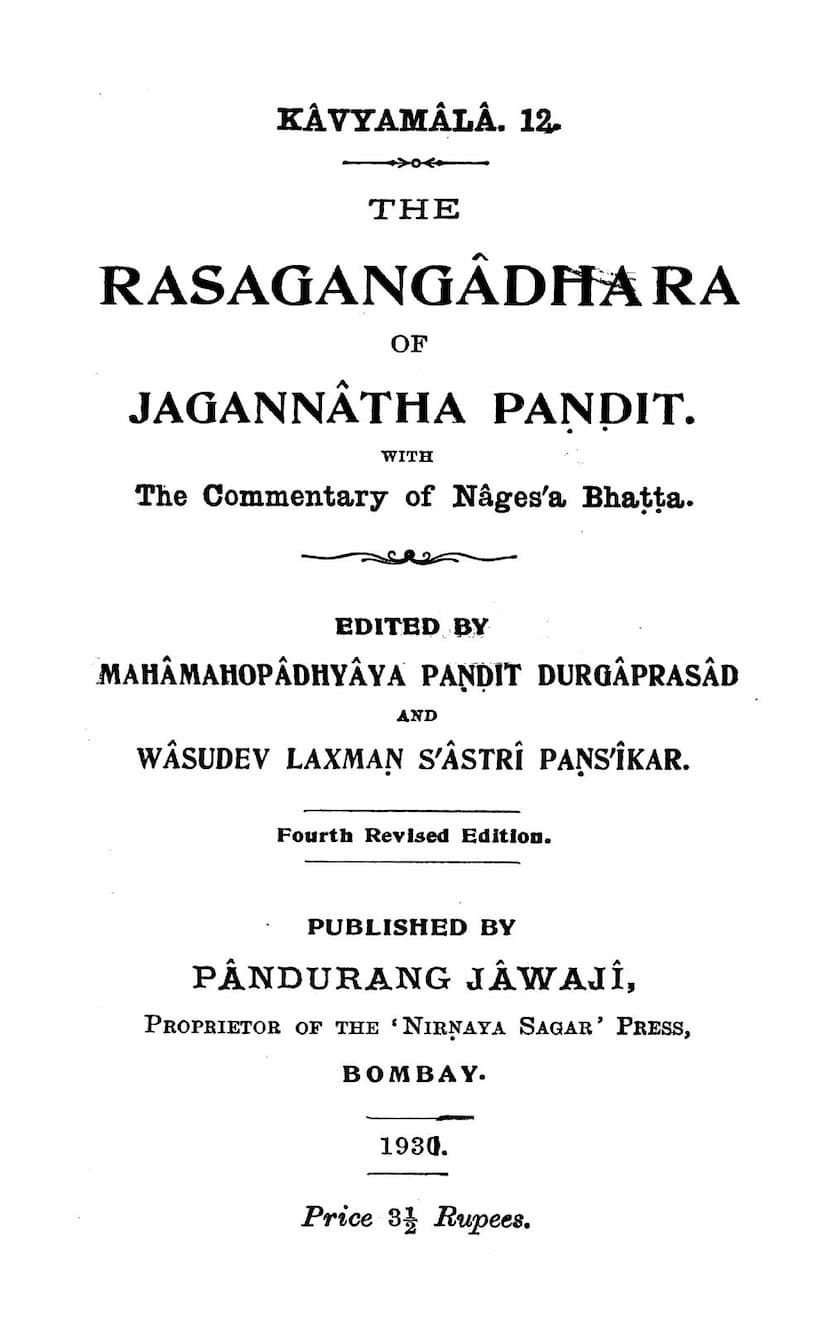Rasgangadhar
Added to library: September 2, 2025

Summary
Here's a comprehensive summary of the Jain text "Rasagangadhar," based on the provided catalog link and the content of the pages:
Book Title: Rasagangadhar Author(s): Jagannatha Pandit, Durgaprasad Pandit, Vasudev Laxman Shastri Publisher: Pandurang Jawaji Catalog Link: https://jainqq.org/explore/023028/1
Overall Summary:
"Rasagangadhar" is a seminal work in Sanskrit poetics (Alankara Shastra) authored by Jagannatha Pandit, a renowned scholar. The text is a comprehensive treatise on the nature of poetry (Kavya), focusing on rasa (aesthetic sentiment), guna (qualities), dosha (faults), and alankara (figures of speech). It systematically analyzes the elements that contribute to the beauty and effectiveness of poetry, offering original insights and critiques of earlier theories. The provided pages include the title page, publisher information, preface, a biography of the author, a list of his works, a biography of the commentator Nagesh Bhatta, a table of contents, and the beginning of the text itself with the commentary.
Key Aspects and Content:
-
Author and Context:
- Jagannatha Pandit: Celebrated as Panditraj Jagannath, he was a prolific Sanskrit scholar who lived around the mid-17th century. The preface includes anecdotes about his life, his patronage by Mughal emperors (Shah Jahan), his scholarly debates, and his reverence for the Ganga river. It mentions his possible connection to a "Yavan" princess and his eventual retirement to Varanasi.
- Commentator: The text includes the commentary of Nagesh Bhatta, another prominent Sanskrit scholar, likely from the late 17th or early 18th century, who is known for his work on Sanskrit grammar and poetics.
- Editors: The edition was prepared by Pandit Durgaprasad and Wasudev Laxman Shastri Pansikar, indicating a collaborative effort to present a scholarly and revised version of the text.
- Publisher: Pandurang Jawaji, proprietor of the Nirnaya Sagar Press, Bombay, published this fourth revised edition in 1930.
-
Content of "Rasagangadhar":
- Poetics (Alankara Shastra): The book is a foundational text in this field, aiming to explain the principles of aesthetics in poetry.
- Rasa (Aesthetic Sentiment): Jagannatha Pandit delves into the concept of rasa, discussing its nature, classification (the nine rasas like Shringara, Karuna, Shanta, etc.), and the complex philosophical underpinnings of aesthetic experience, potentially linking it to Brahmananda (bliss of Brahman).
- Alankara (Figures of Speech): A significant portion of the text is dedicated to the detailed analysis and classification of various figures of speech (Alankaras) such as Upama (simile), Rupaka (metaphor), Virodhabhasa (contradiction), Vihavana (hyperbole), Arthantanyasa (inference), and many others. The text explores their definitions, classifications, examples, and nuances.
- Guna (Qualities): The text discusses poetic qualities (Shabdaguna and Arthaguna) like Madhurya (sweetness), Ojas (vigor), Prasada (clarity), Sukumarta (gracefulness), etc., and their role in enhancing poetry.
- Dosha (Faults): Jagannatha Pandit also analyzes poetic faults that detract from the beauty of a composition.
- Dhvani (Suggestion/Implication): The concept of Dhvani, a central idea in later Indian poetics, is also likely explored, distinguishing between different types like Sanketakrama Dhvani and Lakshyakrama Dhvani.
- Discussions and Debates: The text engages with and critiques the theories of earlier proponents of poetics like Mammata (author of Kavyaprakasha), Bhamaha, Dandin, Anandavardhana, and Appayya Dikshita, presenting Jagannatha's own interpretations and innovations. The preface acknowledges the publisher's efforts to print this work due to its profound importance and the encouragement received from scholars.
-
Structure and Organization:
- The table of contents (Pages 13-16) reveals a detailed breakdown of the text, covering sections like "Kavya Lakshana" (Definition of Poetry), "Rasa Swarupa" (Nature of Rasa), "Guna Nirupana" (Analysis of Qualities), and extensive discussions on various "Alankaras" (Figures of Speech). The text is divided into "Mananas" (sections or chapters).
-
Bibliographical Information:
- The publication date is 1930.
- The inclusion of "Kavyamala" series number 12 indicates it's part of a larger collection of important Sanskrit literary works.
- The price is mentioned as 3 Rupees, which was a significant sum for a book in 1930.
In essence, "Rasagangadhar" is a scholarly and thorough exploration of Sanskrit poetics, offering a deep dive into the theoretical and practical aspects of composing and appreciating poetry, with Jagannatha Pandit's unique perspective shaping its content. The edition by Pandurang Jawaji is a significant contribution to making this classic text accessible to a wider audience.